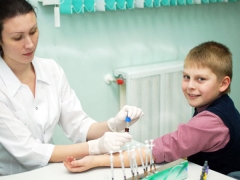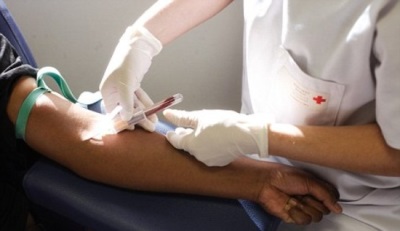Blood test for allergies in children
One of the modern methods of determining allergy in babies is blood test of children. This method has its advantages over traditional skin allergy tests.
Why donate blood?
In the blood of a child with allergies are antibodies that are formed during allergic reactions. They are represented by class E immunoglobulins. A blood test was sent to identify these particular antibodies, during which you can simultaneously recognize the effects on the body of a child of dozens of allergens.
With this method of allergological examination, the child will not have a clinical response to allergens, and an increased level of Ig E will indicate the presence of allergy.
Indications
Blood tests are carried out at:
- Pollinosis;
- Eczema;
- Drug allergies;
- Bronchial asthma;
- Atopic dermatitis;
- Food allergies;
- Helminthiasis;
- Inflammatory diseases of the respiratory system.
It is also advised to donate blood in order to assess the risks of the occurrence of allergic diseases in children, in whose family there are patients with allergies.

Pros compared to skin breakdown
- The child is not in contact with allergens directly, so the blood test is safe and can be carried out at any stage of allergic diseases.
- The accuracy of the blood test is very high. Tests help to identify specific allergens that are dangerous to the child.
- To identify the reaction to dozens of allergens, one analysis is enough.
- Such an analysis will help out if the child has damaged skin.
- It can be carried out in childhood.
- It will not harm children who have had anaphylactic reactions in the past.
Training
When blood is used to identify allergies, the analysis is recommended to take in the morning. It is best if the blood is sampled on an empty stomach. If the child has had breakfast, it is advised to take a blood sample three hours later.
Within three to five days prior to blood sampling, food products that may cause allergies and contact with pets should be discarded. During this period, considerable physical exertion should also be avoided.
How do the analysis?
For the analysis of allergies need venous blood of the child. It is often obtained from a vein located in the area of the elbow bend. The nurse pulls the harness above this area to make the vein more visible and full. After a vein has been punctured, the right amount of blood is drawn into the tube. The result is usually given out within seven days after drawing blood.
Norm values
The normal level of Ig E in children is the amount of antibodies:
- From the fifth day of life up to 1 year - up to 15 U / ml;
- From 1 year to 6 years of age - up to 60 U / ml;
- From 6 to 10 years - up to 90 U / ml;
- In 10-16 years - up to 200 U / ml;
- At the age of 16 - up to 100 IU / ml.
In the results of the blood test, you will see the advantages:
- If there are no pluses, then the level of detected antibodies is less than 50 U / ml;
- “+” Indicates the level of antibodies from 50 to 100 U / ml, that is, low sensitivity;
- “++” indicates moderate sensitivity and level of antibodies from 100 to 200 U / ml;
- "+++" set at high sensitivity when the level of antibodies exceeds 200 U / ml.





